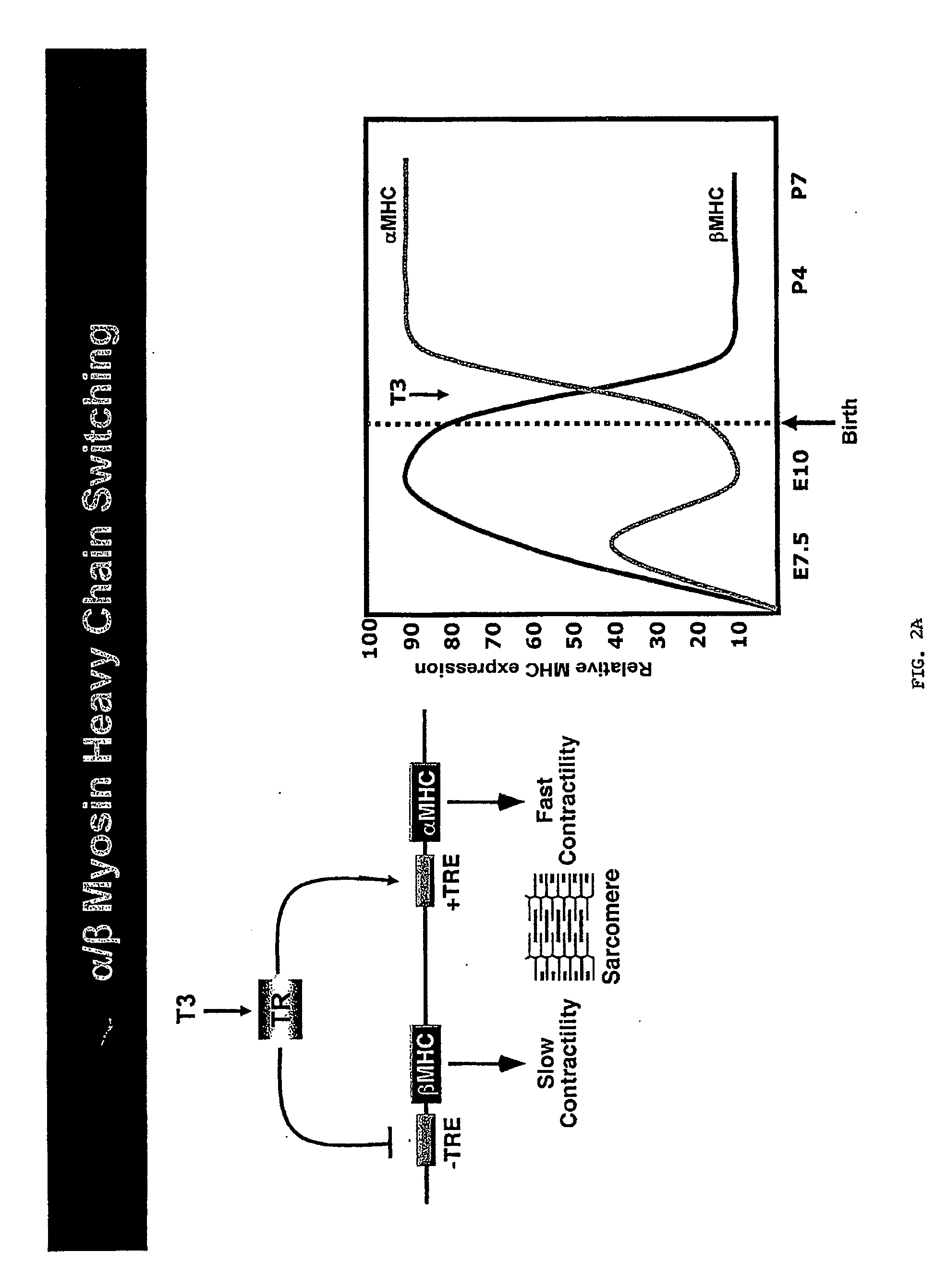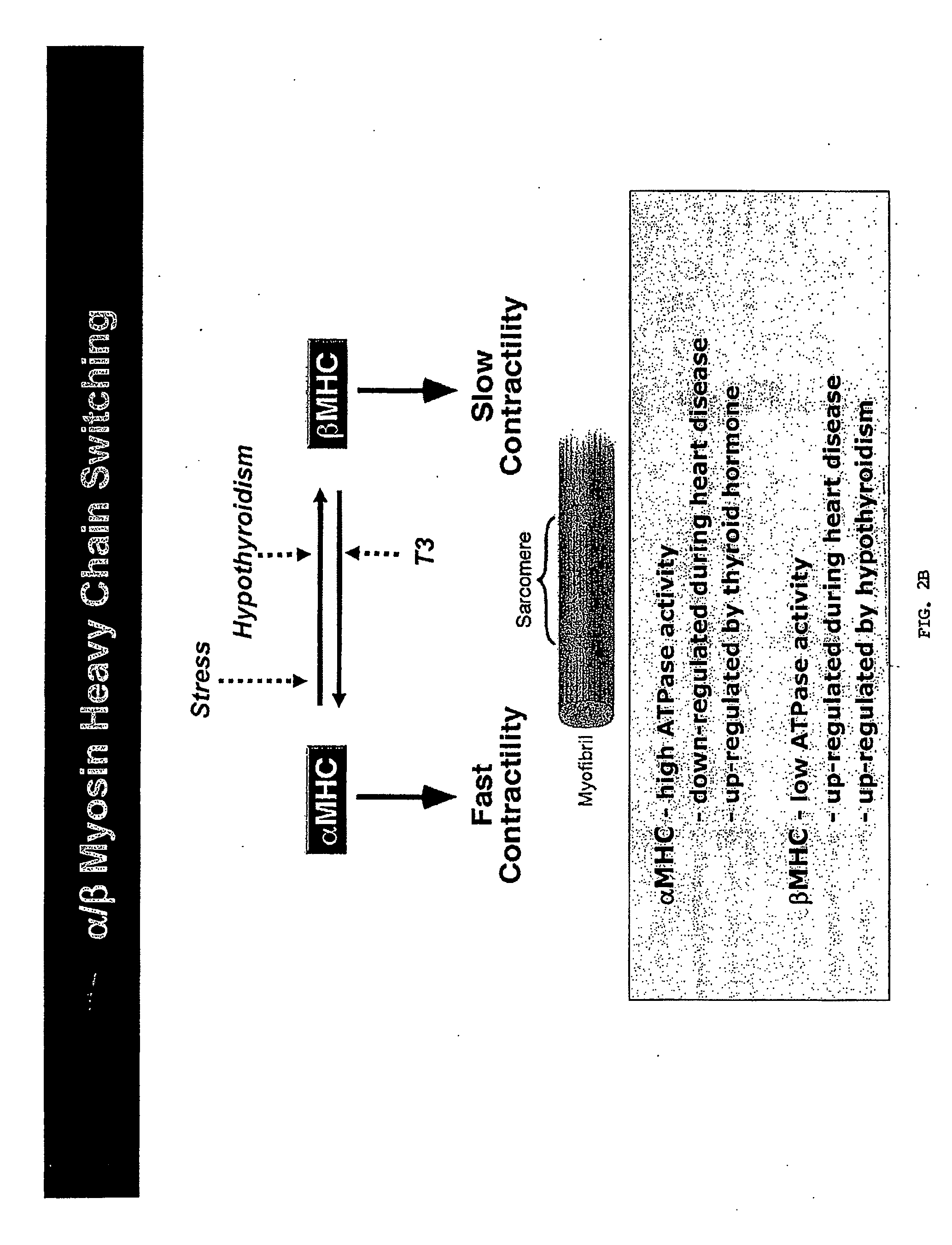Micro-rnas that control myosin expression and myofiber identity
a micro-rna and myofiber technology, applied in the field of development biology and molecular biology, can solve the problems of dilated cardiomyopathy (dcm), a major health risk, and a sudden death of patients, and achieve the effect of inhibiting expression or activity
- Summary
- Abstract
- Description
- Claims
- Application Information
AI Technical Summary
Benefits of technology
Problems solved by technology
Method used
Image
Examples
example 1
miR-208 is Required for Expression of miR-499
[0263]To further explore the mechanism of action of miR-208 in the heart, the inventors defined the microRNA expression patterns in hearts from wild type and miR-208 null mice by microarray analysis. Among several microRNAs that were up- and down-regulated in mutant hearts, the inventors discovered that miR-499 was highly abundant in normal hearts, but was not expressed above background levels in miR-208 mutants. These findings were confirmed by Northern blot (FIG. 14). Analysis of the genomic location of the miR-499 gene showed it to be contained within the 20th intron of the Myh7b gene, a homolog of the α-MHC gene (FIG. 15). miR-208 appears to regulate Myh7b and thereby miR-499 expression at the level of transcription since RT-PCR for myh7b indicates that the mRNA of the host gene is dose-dependently abrogated in the absence of miR-208 (FIG. 14). The Myh7b gene is conserved in vertebrates and is expressed solely in the heart and slow sk...
example 2
MEF2 Regulates miR-499 Expression in Cardiac and Skeletal Muscle
[0264]Within the 5′ flanking region of the Myh7 gene, the inventors identified a potential MEF2 consensus sequence that was conserved across species. This sequence bound MEF2 avidly in gel mobility shift assays (FIG. 37A), and mutation of this sequence abolished both binding (FIG. 37A) and transcriptional activation of a luciferase reporter by MEF2 (FIG. 37B). The promoter region of the Myh7 gene was fused to a lacZ reporter and transgenic mice were generated. As shown in FIG. 37C, this genomic region was sufficient to direct lacZ expression specifically in the heart at E12.5. In the postnatal heart, lacZ staining was observed only in the ventricles, consistent with in situ hybridization (data not shown). Mutation of the MEF2 site completely eliminated expression of the lacZ transgene (FIG. 37C). Northern blot analysis on in vivo mouse models also showed the expression of miR-499 to be sensitive to MEF2. Cardiac-specifi...
example 3
Identification of Targets for miR-499
[0266]Given the sequence homology between miR-208 and miR-499 and the inventors' previous data demonstrating that genetic disruption of miR-208 lead to a strong induction of specifically fast skeletal muscle genes and repression of β-MHC in the heart, it is likely that miR-499 has a comparable function in skeletal muscle and could act as a dominant regulator of fiber type. Expression of miR-499 and its host transcript are regulated by the myogenic transcription factor MEF2, a positive regulator of slow fiber gene expression and muscle endurance. The inventors suggest that the fiber type regulation of miR-499 is likely to be dependent on target genes of miR-499 involved in fiber type regulation.
[0267]MiR-208 is highly homologous to miR-499 and, the remarkable fact that both microRNAs are encoded by introns of Mhc genes, suggests that they share common regulatory mechanisms. Since miRNAs negatively influence gene expression in a sequence specific m...
PUM
| Property | Measurement | Unit |
|---|---|---|
| Time | aaaaa | aaaaa |
Abstract
Description
Claims
Application Information
 Login to View More
Login to View More - R&D
- Intellectual Property
- Life Sciences
- Materials
- Tech Scout
- Unparalleled Data Quality
- Higher Quality Content
- 60% Fewer Hallucinations
Browse by: Latest US Patents, China's latest patents, Technical Efficacy Thesaurus, Application Domain, Technology Topic, Popular Technical Reports.
© 2025 PatSnap. All rights reserved.Legal|Privacy policy|Modern Slavery Act Transparency Statement|Sitemap|About US| Contact US: help@patsnap.com



